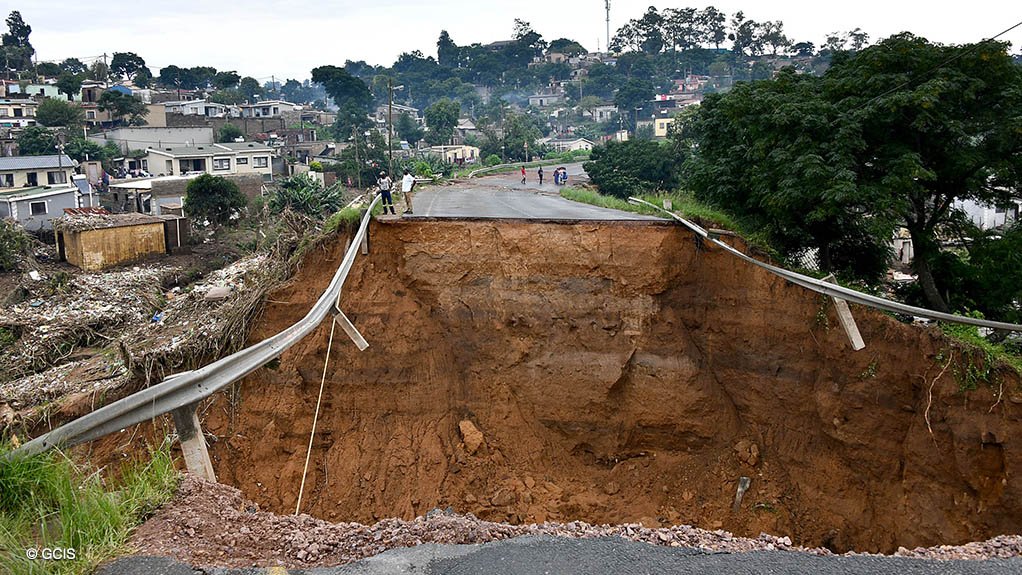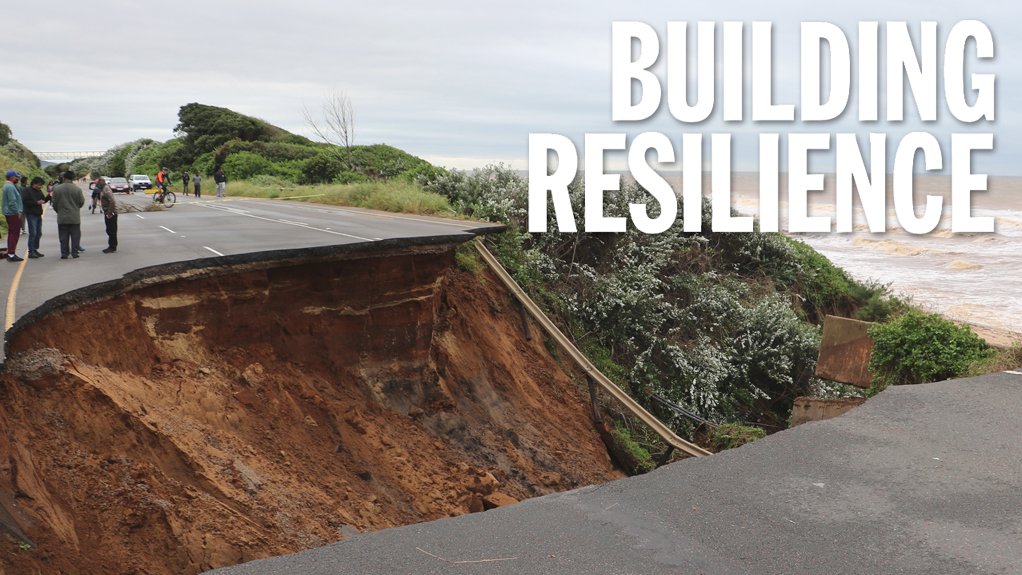Growing need to embed climate resilience into SA’s infrastructure



NEW NORMAL? The floods experienced in KwaZulu-Natal earlier this year killed more than 400 people, immobilised business activity in parts of the province and caused considerable infrastructure damage
Photo by GCIS
News about extreme weather events has become a monthly occurrence, highlighting the importance of embedding some measure of infrastructure and societal resilience in the evolving climate.
Damage to the built and natural environments disrupts socioeconomic activity, but the general public, naturally, tends to focus on visibly dramatic and/or traumatic events, often ignoring the more understated impacts of climate change.
For example, while most people know about the wildfires that affected Europe last month, far fewer are aware that France had trouble cooling some of its nuclear reactors because the record-breaking heatwave meant that the rivers were too warm.
As reported by news agency Reuters on July 15, four of the nuclear power plants operated by Electricite de France had to impose production restrictions because of higher-than-expected water temperatures in and along the Rhône and Garonne rivers.
Reuters also reported the potential of further impacts on electricity production, as “some coal-to-power stations also need cooling water from rivers”.
Moreover, while drought can often invoke visions of queues at water tankers and failing crops, the impact on sewage infrastructure is rarely considered.
During the launch of the book Towards the Blue-Green City: Building Urban Water Resilience in June, co-author and University of the Western Cape Institute for Water Studies’ Professor Jenny Day noted that “less water flowing in sewers [means that] the sewers are more vulnerable to blockages and, therefore, to overflows”.
Further, as people flush toilets less frequently to conserve water, the amount of sewage reaching wastewater treatment plants decreases, creating a “vicious cycle of failing wastewater treatment plants, [even] less water available, and less effluent, which could’ve perhaps been recycled”.
Both examples illustrate that the effects of climate change can be much more subtle than physical destruction and, as international organisation the Global Centre on Adaptation (GCA) notes, the interconnected nature of infrastructure systems means that significant disruption in one aspect can “exert a significant human toll”.
GCA CEO Patrick Verkooijen notes that “every corporation and individual is vulnerable to climate risk because they all depend, to some degree, on infrastructure. Ensuring that these infrastructure systems can operate under future climate scenarios is vital for us and our economies”.
He adds that the cost of infrastructure damage will increase exponentially by 2050. Citing Ghana as an example, he notes that climate risk could lead to $3.9-billion worth of damage to the transport sector by 2050. This would, in addition to strangling the Ghanaian economy, risk cutting off 80% of the population from access to healthcare.
The costs of extreme weather events are escalating. The floods experienced in KwaZulu-Natal earlier this year killed more than 400 people, immobilised business activity in parts of the province and caused considerable infrastructure damage, with Parliament’s Ad Hoc Joint Committee on Flood Disaster Relief and Recovery estimating that repairs would cost at least R17-billion.
It is, therefore, evident that infrastructure resilience is key to long-term sustainability because, as Deloitte Africa Climate and Sustainability leader Mark Victor notes, resilient systems improve the ability of a society to withstand shocks.
Creating infrastructure resilience requires that local governments understand the current and future impact of climate change on the built and natural environment, and all the potential implications of climate risks. They should also model the risk impacts and use such models to create a comprehensive and strategic plan to help drive resilience, he explains.
Council for Scientific and Industrial Research (CSIR) senior researcher Willemien van Niekerk notes that, while the CSIR and other entities have been collecting and interpreting data to assist government in developing climate-resilient settlements, local settlements remain “very vulnerable” to the impacts of climate change.
This is because some infrastructure and settlements are poorly located: “Structures are built within flood lines, on sloped, hilly areas, making them more susceptible to flooding or landslides,” she comments.
Victor adds that this is partly so because developments are often not designed to withstand either extreme weather-related events or the climatic changes that could emerge.
“There are environmental regulations and environmental-impact assessments embedded into the legislative framework. But when new infrastructure or buildings are built, the challenge is not only to understand the environmental impact as a one-off to get approval but also to factor in climate change scenarios and how the environmental impact might change as a result.”
This dynamic approach to incorporating climate data into urban planning and infrastructure design is crucial because, as Van Niekerk points out, “the likelihood of a hazard occurring is increasing and the level of exposure and vulnerability to such hazards is increasing as well”.
Therefore, aspects such as age and poverty, which render people vulnerable, also make them more vulnerable to the impacts of climate change. As such, “the risk of a disaster happening in our cities and towns is growing over time”.
Van Niekerk adds that temperatures are increasing nationwide, but particularly in the northern parts of South Africa, including the Northern Cape, Limpopo, North West and Mpumalanga provinces, all of which are projected to become hotter and, crucially, drier.
Meanwhile, coastal cities have to contend with rising sea levels and the effects of variable rainfall, although the latter is already a reality across all provinces.
“We cannot do anything about the likelihood of a weather-based hazard occurring, but we can reduce vulnerability and we can reduce exposure,” she adds.
A Question of Funds
Van Niekerk and Victor note that, while infrastructure development is expensive, there are cost-effective measures to reduce risk and create resilience.
“There are three ways of reducing climate risk: retreat, accommodate and protect,” says Van Niekerk.
The first involves moving settlements away from areas that are overly exposed to climate risk or ensuring that new settlements or structures are not erected in those areas.
The second requires maintaining and/or retrofitting key infrastructure, such as stormwater drainage systems or water reticulation systems, so that they function as envisioned when disaster strikes, enabling society to ‘accommodate’ the flood or drought, without large-scale losses.
“‘Protect’ entails the construction of hard infrastructure – such as a sea wall for coastal cities – to protect the financial and social investment in settlements where ‘retreat’ is not an option,” explains Van Niekerk.
She and Victor also advocate for the use of nature-based solutions such as controlling alien plants, restoring wetlands, recharging aquifers and providing buffer zones.
“We can manage the existing infrastructure and identify where infrastructure needs to be enhanced because a big part of the damage that occurs before, during and after an extreme weather event is owing to poor service delivery and infrastructure management,” Victor comments.
Van Niekerk, Victor and the GCA all emphasise the need to invest better by applying climate data to prioritise interventions in the most exposed areas, with the GCA noting that an integrated approach could reduce the additional costs of building up resilience by 90%, compared with following an untargeted approach.
However, the GCA also regards the development of hard infrastructure as a potential means for societal upliftment.
A 2020 GCA Policy Document, published in the wake of Covid-19, notes that “to sustain Africa’s growth, and speed up efforts to end extreme poverty, investment in resilient infrastructure is fundamental”.
“Low- and middle-income countries alone could see a net benefit of $4.2 trillion from investing in infrastructure that prioritises future-focused resilience. That’s a $4 return for every $1 spent. By contrast, investing in business-as-usual infrastructure not optimised for resilience only returns $1.5 for every $1 spent,” the policy document states.
The report notes that resilient infrastructure investments are employment intensive and have a high return on investment, “making them an important tool to overcome the current economic crisis while safeguarding livelihoods”.
It also states that “attracting institutional investors to African infrastructure projects and bringing that source of financing to scale will require developing new financial instruments”, citing options such as investing directly in African infrastructure through infrastructure funds or leveraging African pension funds.
Victor adds that the incentive structure of a well-constructed public–private partnership (PPP) would reduce project risk, while ensuring that the project delivered long-term, sustainable outcomes.
The GCA, in partnership with the World Bank, the African Development Bank, the Asian Development Bank, the European Investment Bank, the European Bank for Reconstruction and Development, and other partners, last year launched the ‘Knowledge Module on PPPs for Climate-Resilient Infrastructure’ guide as a step towards helping countries entice the private sector to assist in financing climate-resilient infrastructure.
It also mobilised $1.6-billion over the first two quarters of this year, which was used to progress adaptation interventions in Ghana, Senegal and other African countries.
Van Niekerk adds that the CSIR frequently engages with the Department of Forestry, Fisheries and the Environment and will look to update its Green Book, which provides climate-change projections per eight square kilometres for South Africa. In this way, the CSIR is actively aiding the development of climate adaptation plans, which all spheres of government can use in their long-term planning.
Similarly, Victor notes that Deloitte works with clients, governments and municipalities to model scenarios and the potential impacts of temperature increases of 1.5 ºC, 2 ºC or even 8 ºC.
However, he suggests that there be more interaction and engagement between provincial entities, institutions and the private sector in creating viable business cases for PPP projects that will have the biggest impact on creating resilience.
The current levels of engagement between these parties and development finance institutions are also insufficient, he adds.
“Climate change is already bringing more damage, stress and suffering to the world’s cities, which house more than half of the global population and produce 80% of global gross domestic product. But, by increasing the resilience and reliability of infrastructure, regions can create new jobs, unlock economic potential by encouraging investment and continue to thrive in a warming world,” Verkooijen concludes.
Comments
Press Office
Announcements
What's On
Subscribe to improve your user experience...
Option 1 (equivalent of R125 a month):
Receive a weekly copy of Creamer Media's Engineering News & Mining Weekly magazine
(print copy for those in South Africa and e-magazine for those outside of South Africa)
Receive daily email newsletters
Access to full search results
Access archive of magazine back copies
Access to Projects in Progress
Access to ONE Research Report of your choice in PDF format
Option 2 (equivalent of R375 a month):
All benefits from Option 1
PLUS
Access to Creamer Media's Research Channel Africa for ALL Research Reports, in PDF format, on various industrial and mining sectors
including Electricity; Water; Energy Transition; Hydrogen; Roads, Rail and Ports; Coal; Gold; Platinum; Battery Metals; etc.
Already a subscriber?
Forgotten your password?
Receive weekly copy of Creamer Media's Engineering News & Mining Weekly magazine (print copy for those in South Africa and e-magazine for those outside of South Africa)
➕
Recieve daily email newsletters
➕
Access to full search results
➕
Access archive of magazine back copies
➕
Access to Projects in Progress
➕
Access to ONE Research Report of your choice in PDF format
RESEARCH CHANNEL AFRICA
R4500 (equivalent of R375 a month)
SUBSCRIBEAll benefits from Option 1
➕
Access to Creamer Media's Research Channel Africa for ALL Research Reports on various industrial and mining sectors, in PDF format, including on:
Electricity
➕
Water
➕
Energy Transition
➕
Hydrogen
➕
Roads, Rail and Ports
➕
Coal
➕
Gold
➕
Platinum
➕
Battery Metals
➕
etc.
Receive all benefits from Option 1 or Option 2 delivered to numerous people at your company
➕
Multiple User names and Passwords for simultaneous log-ins
➕
Intranet integration access to all in your organisation




















